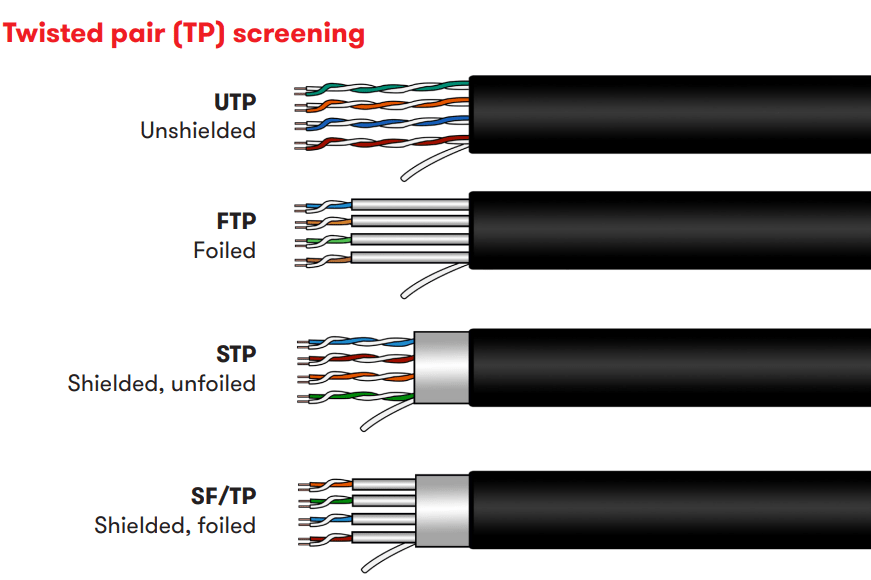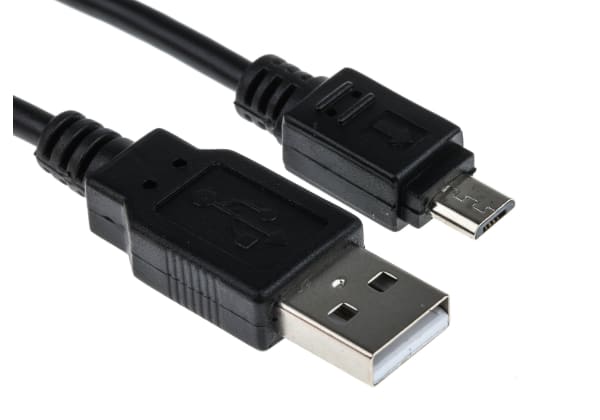- Published 18 Sept 2024
- Last Modified 18 Sept 2024
- 6 min
A Guide to Twisted Pair Cables
What are twisted pair cables and where are they found? Learn about how twisted pair cables work, their applications, and how to tell twisted cable types apart.
What is a twisted pair cable? It is a pair, or a group of pairs, of wires twisted together and encased in a common jacket. The cable transmits signals while preventing receiving or creating signal interference. Twisted pair technology is more than 100 years old and still has advantages and applications to this day.
What Are Twisted Pair Cables?
A twisted pair cable is, simply, two individually insulated metal wires twisted together. These wires carry a signal in opposite directions. Together, they effectively and inexpensively transmit signals with minimal interference, and they have good physical flexibility.
Multiple pairs may be grouped together in a single jacket, and this group may be generally called a ‘twisted pair cable’. In this case, all the individual cables are colour-coded to make connecting them to the right things simpler.
How Do Twisted Pair Cables Work?
So how does twisted pair cable work? Twisting the wires protects the signal they carry from outside interference and in turn helps prevent interfering with signals of adjacent cables.
Any wire with a flowing current emits a magnetic field. Those fields in the high frequencies of signal transmission can induce signals in nearby wires, and this interference is called ‘crosstalk.’ Running a signal’s positive pulses in one wire with corresponding negative pulses in another helps cancel out their equal and opposite fields, but if the wires are simply running in parallel their fields can still overlap and produce crosstalk.
Twisting the wires, though, continually offsets the wires’ fields and reduces their crosstalk. The twists also help balance external sources’ interference on the wires into a common mode so that the pair’s receiving unit can filter out the noise it sees equally on each wire.
Varying individual pairs’ twist rates, or twists per unit length, further offsets the wires’ fields and reduces crosstalk even more.
Twisted Pair Advantages
Along with its primary benefits in preventing signal interference, the advantages of twisted pair cable lie in its simplicity. Since these cables are thin, with minimal materials used, they are inexpensive to produce.
They also offer superior flexibility, both in their ease of bending into complex routes and in being able to handle bending during operation — all while maintaining signal quality.
Twisted pair cables are also straightforward to add to wire harnesses and enclosures, especially when space is tight, and making up their connections is simple. Finally, they are a good choice for connecting to older technology.
Twisted Pair Compared to Other Cable Types
But what about the much newer technologies of coaxial and fibre optic cables?
Twisted Pair vs Coaxial: Coaxial cables are thicker and better shielded than twisted pairs. This lets them carry signals cleanly over longer distances than twisted pairs, and at higher speeds. However, this also makes coaxial cable less flexible and more expensive. Coaxial cables are used for internet and television signals, especially over long distances.
Twisted Pair vs Fibre Optic: Fibre optics uses pulses of light rather than conducting metal to send signals. This cuts electromagnetic radiation interference right out, making these cables far superior for sending lossless signals and for long-distance transmission. Fibre optic cables are more expensive, though, and more fragile and difficult to install.
Twisted pair wire is an older technology, though simple and effective. It isn’t the absolute best at sending clean signals, but its other advantages mean it still has uses today.
Twisted Pair Cable Uses
Twisted pair wire is useful in various signal transmission applications:

- Telephones: Twisted pair cables’ original purpose was reducing literal cross-talking between telephone lines, and this continues today in dedicated telephone lines.
- LAN: Cables for connecting computers on the same local area network.
- Ethernet: A common type of LAN cable used for workplace computers.
- Closed Circuit Cameras: Cables for security cameras, which need to ensure their signals don’t bleed out of their closed circuits.
- Digital Subscriber Lines: DSL lines are internet-capable twisted pair telephone wires. They have limited bandwidth since they were originally meant to carry audio signals only.
- HDMI: Used to connect modern media devices, HDMI cables feature four shielded twisted pairs.
Twisted Pair Cable Types
Twisted pair cable types consider the cable’s conductor wires, shielding, and industry standards. This creates a wide assortment of twisted pair wires and uses for them.
Twisted Pair Conductors
The individual wires in a twisted pair can be either solid or stranded.
- Solid: An insulator with one single, contiguous copper wire strand inside.
- Stranded: Multiple copper wires woven inside an insulator.
In general, solid conductors have better conduction performance while stranded conductors are more flexible. Solid conductors also have sturdier connections and can better withstand vibration and corrosion.
If you’re after sturdy cable with minimal signal loss over longer distances, go with solid conductors. If you want the flexibility advantages of twisted pair cable, especially for flexibility during operation, stranded conductors may be the better choice.
Twisted Pair Shielding
The principal twisted pair cable category to consider is the extra shielding layers.
All twisted pair cables have this baseline shielding:
- The insulation on each pair’s two wires (colour-coded).
- The pair-group’s outer jacket, which is often PVC.
With those assumed as present, twisted pair designations are either shielded (STP) or unshielded (UTP). The shielding in this case refers to any additional layer or layers between the jacket and the pairs. A cable can have a braided shield, a foil shield, or both. This shield further helps prevent crosstalk.
Furthermore, any of these cables may have foil shielding around their individual twisted pairs.
- So what is UTP cable? Unshielded twisted pair cable has no foil or braided shield under its jacket, but its pairs may still have foil shielding.
- Now, what is an STP cable? Shielded twisted pair cable has a foil or braided shield, with or without foil shielding on its pairs.
The following twisted pair cable diagram illustrates the difference between shielded and unshielded twisted pair cable, along with the foiled versions of those:

Twisted Pair Categories
Twisted pair cable types also involve industry classifications.
ISO 11801 defines the following classes, which are in order of increasing transmission rate: A, B, C, D, E, EA, F, and FA.
ANSI/TIA-568, however, defines categories in order of increasing bandwidth: 1, 2, 3, 4, 5, 5e, 6, 6a, 7, 7a, and 8.
Wires in each of these groups have suitable applications based on their properties. Twisted pair ethernet cables in homes, for example, can be Category 5e.
Reading Twisted Pair Acronyms
Along with its Classes, ISO 11801 also defines the nomenclature for twisted pair shielding: XX/XXX
The XX indicates the shielding for the group of pairs:
- U: No shielding.
- S: Braided shielding.
- F: Foil shielding.
- SF: Both braided and foil shielding layers.
The XXX always ends with ‘TP,’ and begins with either ‘U’ or ‘F’ to indicate whether the individual pairs are unshielded or have foil shielding, respectively.
Examples:
- S/FTP: The pairs each have foil shielding and are grouped in braided shielding.
- SF/UTP: Unshielded pairs, though they’re grouped within braided and foil shielding layers.
RS has twisted pair wire for all the combinations of these different categories. Browse these offerings today to make your connections.
Related Articles
Related links
- Twisted Pair & Multicore Data Cable
- Belden RS-485 Cable
- Belden 9842NH Series Control Cable 24 AWG Shielded Shield, Twisted Pair Cable
- NewLink Twisted Pair Cable 24 AWG Cat5e Cable
- Alpha Wire ProTekt Series Twisted Pair Cable 0.1829 mm2 26 Twisted Pair Cable
- Helukabel Twisted Pair Cable 2.5 mm² 100m, Mains Cable
- Belden 3107ENH Series Control Cable 22 AWG Shielded Shield, Twisted Pair Cable
- Lapp Twisted Pair Cable 0.34 mm² 22 AWG Data Cable



